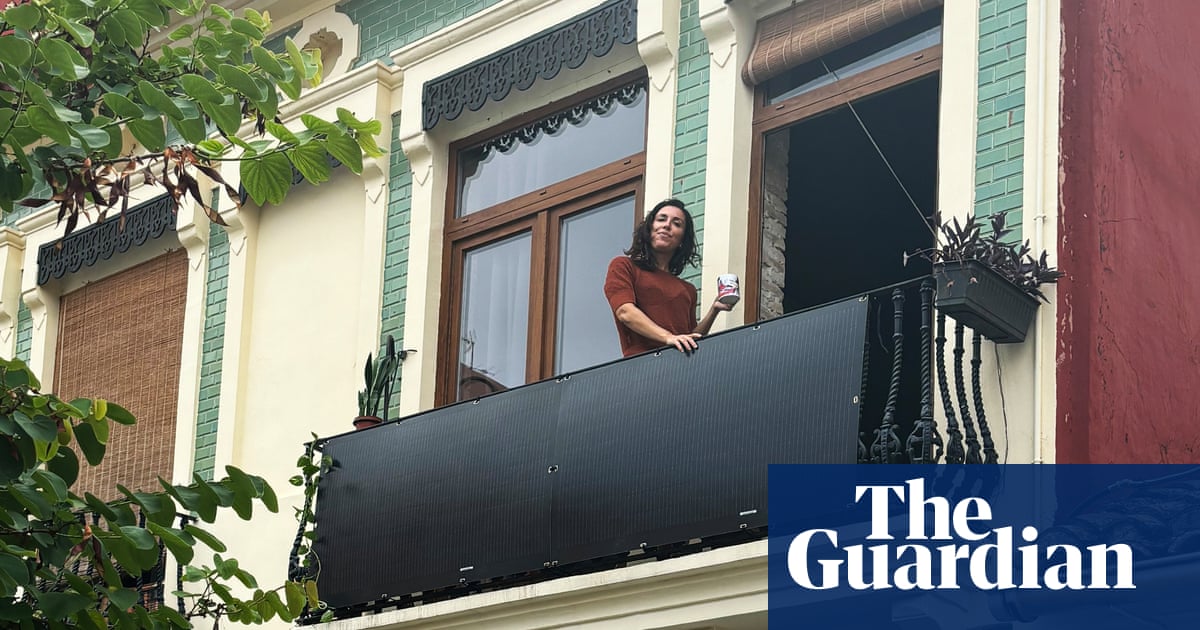“Plug-in solar is part of the whole array of options,”
I don’t understand how this works? For our system we need an inverter that cost about $3000.- (half if it doesn’t have to handle a battery), and it needs to be installed by an authorized electrician.
For a small system as the one shown, the price of panels are peanuts, the 2 panels shown should cost less than $150 combined. While the cost of inverter and getting it connected is way way higher. There’s a lot more to this than not being on the roof!?! But which isn’t disclosed.The article says nothing about how the power from those panels is made usable.
Have a look here: https://en.m.wikipedia.org/wiki/Balcony_solar_power
OK thanks, so they are indeed complete systems including inverter, so it can be connected to the grid.
I suppose they’ve made some cheap low power inverters then, but the power still needs to have stable voltage an frequency and synchronization. So I wonder how cheap it’s possible to make?
I also suppose it still needs an authorized electrician to connect it? Unless Germany has some fancy system that is prepared for “plug in” connection of a local power source.In the EU, as long as it’s under 800W it can be plugged directly into an outlet in your home without any kind of installation, back-feeding the grid that way.
You’re not getting paid anything for the power you send back into the grid so anything you don’t use you lose.
Still very cool, because selling surplus power is almost completely worthless anyway. (at least it is here)
In the summer when you can sell, prices are generally extremely low, we have sold about twice what we use, but the value of selling is only about 5-10% on average, compared to the savings of using it ourselves. That’s because the price often drop to close to zero in the middle of the day, and sometimes even below.
Electricity itself is dirt cheap, the reason the prices are high are transportation and taxes, and short peak prices in the evening. Here transportation alone is more than the electricity itself during winter.
And we are only paid the pure electricity price here, which I suppose is the case most places.
It literally plugs into the wall.
That’s amazing. 😀
If you pay 3000€ for an inverter then that’s probably included installing and whatnot. You can get a cheap 50€ 4kW inverter on aliexpress, or an expensive 500€ 10kW one.
No the price was not including installation, We have 11.2 kW panels and 7.5 kWh batteries. Installation was almost $5000.- !! That was probably mostly the 28 panels on the roof. But we had one installer handling everything, who was also responsible for the electrician.
That’s a massive installation though! Wow!
Also, you got a biig roof!
When we bought the house, that was one of the parameters on our list for “the perfect house”. So the roof to the garden is also almost perfectly towards the south. 😀
Even in January we’ve made 41% of our power consumption from the solar panels. 😎 You are right that it is a bit oversized according to “normal” recommendations which are 8 kWh for a house the size of ours, but we went a bit bigger in preparation for air to water heat pump, so warming the house will be electric, (currently wood pellets), and also we plan to buy an electric car within the next 2 years.Also it was a bit for fun, because of the movie spinal tap, so our panels go to 11 instead of just 10, because we need that little bit extra. 😋
Smart planning! Thanks for the story, are you planning to go off grid or is it just to be economically free? Any batteries in the future? Excellent reference, and implementation, I’m giving you an 11 out of ten!
Thanks. 😀
Going off grid was absolutely a consideration, but only for a very short while. There are too many downsides. We would need twice as much solar capacity, and a way bigger battery, and batteries are still pretty expensive, but even with that, we would still need a generator. And we wouldn’t be able to sell surplus energy. It would more than double the cost, and only provide 25% better self sufficiency for the whole year than we have now.
We live in Denmark, and we can risk to have to go through almost all of December with only a few days sun. Running a diesel generator for power would be both noisy and smelly, It would also require more work to maintain, and it would actually cost slightly more to us a generator than to simply buy the electricity from the grid.Remember doubling our capacity will not bring us from 41 to 82% self sufficiency. Because there is some loss in storage, and even double our battery capacity would not be enough to store 48 kWh like we made today in the span of only 7 hours. (Today was the best day of the year yet. 😎)
Even in January on a perfect day, we can make twice what we use, but such days are rare in January. (we use about 15 kWh per day.)The final problem with a generator is that we would never be able to achieve remotely the stability we have with the grid. We’ve been living here for 6½ year, and the power has only been out once!!!
The problem with making it bigger than we have at all, is that after you’ve reached a point of above 50% self sufficiency, you are entering the area of diminishing returns quickly. On a yearly basis we are about 72% self sufficient. To reach that extra 22% probably cost 50% extra.
This is if you live as high north as we do, because the extra capacity is only usable in the winter, in the summer it’s all surplus, and you get so little for selling the power it’s basically irrelevant. There is too much solar now, so when solar panels have high yields, prices often go down to almost zero.
Going off grid is a lot easier if you live further south.
Thanks again for all the information!
Yeah, going off grid is a whole philosophical idea in itself, way smarter to share with the grid if you’re not in some very specific situation IMO.
I always thought that those calculations about solar was a bit bogus, like you extrapolate the earnings today over say 12 years to pay off an installation, of course it will get cheaper in the future and as more people have solar, revenu goes down too. Seems you solidify that idea!
Today though it starts to be almost a criminally good investment… Living in an appartment I seriously think I might get one of those balcony panels this year, just gotta check out how it actually works when ju inject that into the system. We redid all the electricity so we have separate lines for about everything, will the sun powered line hop over to another one (they are after all all tied together at the central input) and how many amps can you allow to flow “backwards” like that and so on.
I wonder if a whole building could use one or two inverters?
I feel that’ll make the cost reasonable
For apartment buildings I don’t think that’s possible, since electricity is a per household connection with separate meter.
There are two main inverter approaches. One big inverter that takes the DC from a bunch of panels and converts it into AC and micro inverters where each panel gets it’s own small one placed directly under the panel.
The micro inverters cost around $150 each. So you need around 10 panels before the single inverter becomes a good choice.
Installers love the micro because the install is easier. However as a owner with say 30 panels you now have 30 points of possible failure instead of the 1.
Oh boy, apparently there’s a lot I don’t know. It’s really cool there are those cheaper options now.
Balcony solar is a set of diy technologies that require no utility permissions.
In Germany, NL, you can just plug it into socket and it works somehow.
In us you can use powerstations and also adapters that sync draw from battery as it charges from ac in house.
It pays for itself even with more expensive equipment, by not needed license, permission, that can lead to cheap efficient panels costing over 3$ per watt. Small systems that just offset use instead of selling back, have higher revenue offsets in high per kwh priced markets.
In Germany, NL, you can just plug it into socket and it works somehow.
This is incredibly dangerous as it will feed power into the grid even when the grid is down. You might say ‘that is great!’, yeah, well, the line technicians who cannot work on damaged cables because you are energizing them think otherwise.
One of the reasons home solar grid-feeding systems are expensive in the US is they have extra equipment to disconnect the system from the grid if the grid goes down. Your house can still have local power, but you won’t be energizing powerlines technicians are trying to fix.
These plugin systems shut down automatically when there’s a power outage. To make sure that they really do shut down when needed, in Belgium only plugin systems that have been approved by the network management organisation may be used. The other countries that allow these probably have similar precautions.
The “balcony” bit isn’t the defining characteristic, it shouldn’t be taken literally. Some people do have their “balcony solar power” on their roofs.
What defines it is limitation to 800 W and inverters that come with a normal Euro Type F (“Schuko”) plug and no legal requirement for professional installation. A layman can literally plug it in to an existing wall socket. Given that they are capped at 800 Watts, the inverters are also the simplest type and dirt cheap (although often they are literally just software-capped and identical to higher power ones, make of that what you will). Complete systems (2 panels, cabling, inverter) cost between 299€ and 800€ depending on quality. You genuinely only have to buy a fixture that suits your needs and a mate to help you install it.
Proper several-Kilowatt-systems are very expensive in Germany too.
Thanks really good info. 👍😀
A layman can literally plug it in to an existing wall socket
That’s amazing, I had no idea that is possible??? Is that special for Germany? (sorry for keeping on with new questions). 😋 I’ve never heard of that option here in Denmark.
cost between 299€ and 800€
No wonder it’s a popular option, our system is of course bigger with 11.2 kWh and 7.5 kWh battery. but it was $17000 1½ year ago. Prices have dropped to $12500 for a similar system, but still such an 800W system is dirt cheap by comparison.
There are already a few requirements for operating the balcony panels, At least here in Germany:
- You need a suitable electricity meter
- You have to register with a relevant authority and inform the electricity provider that you are operating a “balcony power plant”.
- The microconverter should run on its own secured circuit. (“Should”, will certainly do very few) But technically it is simple:
- Set up panels
- Connecting necessary plugs
- Microconverter to the socket
- Be happy that you produce up to 800 watts of your own electricity
I think it’s almost irrelevant how many panels you ultimately split up. However, no more than 800 watts may be fed in.But if you have panels with, let’s say, 2000 watts, you can of course charge various batteries with them beforehand. Nobody can say anything against it.
You need a suitable electricity meter
That makes sense, we also needed new meter, and that was about €200.- with installation. Not a big deal for a big installation, but for a system that can cost only €300.- an extra 200.- would be pretty significant.
Just for your information : belgium is allowing the balcony solar panels this year, but they have put limits on which you can install. The power supplier needs to have approved the kit you install. This is just to prevent people from getting cheap crap from the internet.
Other than that, same rules!Wait really? I didn’t know we finally caught up with the neighbors!
Officially it’s allowed after April 17th, but there’s already an extensive list of approved devices.
https://www.test-aankoop.be/woning-energie/hernieuwbare-energie/nieuws/plug-and-play-zonnepaneel
There’s probably a french version of that article as well, but test- achats/aankoop hasn’t made it easy to switch languages :)
Clearly not special for Germany, since the entire article is… entirely about Spain, actually.
The option highlighted here is very interesting, but as a test of reacting to headlines vs clicking through it’s an amazing case study. The German thing is a quote from a Spanish seller of this tech explaining why he’s confident it will take off.
I had no idea that is possible??? Is that special for Germany?
I mean, the regulation seems to be, but there’s no fancy tech going on. I’m not an electrician but I think I can explain, as I have recently tried to understand myself. To understand why it’s possible it’s best to understand why the limit is at 800 W precisely.
So German wall outlets usually have a 16 A fuse and the wiring in the walls is dimensioned to accommodate slightly higher current (I think they are 2.5mm² gauge allowing up to 20 A but don’t quote me on that particular part) for safety reasons. I suppose it would be the same or very similar in Denmark, or maybe most of Europe that uses 230V/50Hz AC.
Now, normally, if you have dangerously powerful load that would melt your wires, let’s say 5 kW, and you plug it in to an outlet the fuse will just pop and you’re safe. If however you have a 2 kW PV system connected to a wall outlet nearby, it would theoretically be possible that your 5 kW load draws 13 A (3 kW) from the mains through the fuse and another 8.7 A (2 kW) from the PV system over the same wire in the wall that is only rated at 20 A but now carries 21.7 A. And the fuse would never pop at 13 A, making it a huge fire hazard. 800 W is basically just what will always comfortably fit into the safety margin of the wiring in German houses. All systems above 800 W need to be hardwired by professionals “behind” the fuse box so that every Amp from your PV goes through a typical 16 A fuse.
still such an 800W system is dirt cheap by comparison
Absolutely. I guess the low threshold for installation allows some kind of mass market economy of scale whereas systems like yours are homeowners’ luxury goods.
Great post! Thanks for doing the math and explaining the concepts!
Read it as germans who are 1.5 meter tall, wondered why them being short is relevant.
Germans also have 7 times the power bill
I blame Bavaria. If Germany had multiple price zones like other European countries instead of one giant one prices would plummet here in the north, while they’d explode in Bavaria. The state that does not want wind power, does want nuclear power, but already knows ahead of time that its geology (with lots of mountains and granite) is unsuitable for nuclear waste storage. Meanwhile, north German wind power and Scandinavian hydro dams complement each other perfectly. The Bavarians could do the same with the Austrians, they just don’t. They want to eat cake and have it, too.
Am Bavarian can confirm. The CSU has been in power this state since forever. Especially old people just keep voting for them cause it’s the way it always was. They had to form a coalition after the last elections. Their partner is essentially the exact same party but even more right wing. Not even kidding, I could not name a single area where they differ other than their main guy apparently handed out nazi newspapers in his younger years or smth. He blamed it on his brother and then the scandal just died off.
Those small balcony systems pay for them here in Germany at ~35 Cents/kWh in a few months. Even if your power bill is 7x cheaper, they will pay for themselves easily.
nb4 someone laughs at us Germans for pulling out of nuclear power: No, nuclear is not cheap. It’s literally the most expensive way to generate electricity. Solar is cheap and better for the environment.
French electricity enters the chat.
French electricity leaves the chat in summer when their plants need to be shut down because the rivers are too warm or don’t carry enough water in the first place. And that’s nothing to say what they will do in the next decade years when a good portion of their reactors should be commissioned out.
Nuclear is cheaper than your average electricity cost.
I know because I’m Swedish and you use us as your cheap electricity.
No, nuclear is not cheap. It’s literally the most expensive way to generate electricity
Source?
Beats coal anytime. Or Russian gas.
I obviously don’t consider fossil fuels as an option. And I do doubt that it’s cheaper to build a nuclear plant compared do building a coal or gas fired one.
Nuclear is reliable, predictable and stable 24/7 source. Solar not so much and possibly not that great for the environment if we don’t figure out what to do with used solar panels. Also their production is not exactly clean. Whereas nuclear requires a wasted fuel storage somewhere and the fuel will eventually run out of radiation in some hundreds of thousands years.
Storing something extremely dangerous extremely safely for “some hundreds of thousands of years” doesn’t exactly sound cheap, does it?
Not that expensive either. And that’s already included in the energy price. Also volume is magnitudes smaller than used solar panels.
That pic is great, haha. Woman looks so smug.
“100 million smokers can’t be wrong!”
My dumb ass: “Is it just 1.5m Germans, or other heights too?”
1.5m Germans are 150cm people !
M in million should always be capitalised for this reason.
1.5M Germans vs 1.5m Germans
1.5 10^6 Germans vs 1.5 10^-3 Germans
Megagermans vs milligermans
Megagermans just sound evil.
And milligermans, well there’s a vaccine against that I think.
This me me lol. Thank you 😂
Until I read this comment I was 100% certain the post was about short Germans somehow preferring having their balconies occluded by taller-than-them solar panels.
Maybe they’re also nudists, or otherwise like their privacy
This is great for people who live in the middling latitudes.
By putting the solar panel at a 90 degree angle though it is much less efficient than e.g. a 45 degree angle.
The most have a 45 degree angle
Less efficient than not having them?
I hung a solar panel vertically on my fence one time. It was facing west rather than south, but I was only getting about 3-4 watts on my 100 watt panel under the best conditions.
Depends, is an imaginary angle comparable to a 45 degree angle?
Wrong question. The right question is: is the solar panel able to be CO2 neutral (at least) or CO2 negative. We don’t get anything out of it if producing the solar panel costs more CO2 emissions than it saves by producing electricity.
Before you ask: I don’t know the answer. I was looking into this thread in hope to find it.
Most people don’t care about being CO2 neutral. The real question is what is the ROI? Will the panel save that person money. If it takes 50 years to pay for itself, I’d say that’s bad. 10 years is more standard. 5 years I say it’s a no brainer. Though I suppose you can also argue value for utility, if that is giving her the ability to power something off grid that would be worth something.
In Germany those panels usually pay themselves after about 5 years depending on the price of the necessary electronics (don’t forget the electricity meter!) and if there’s also a battery.
You don’t need a smart meter for this, just plug and play. If seen offers for complete sets from as low as 250€ in supermarkets, so almost everyone can get one and start saving some power.
Might be most efficient when power is in higedt demands, in the morning and evenings when everyone is using power at home.
For first few seconds, I deadass though they are talking about Germans with a height of 1,5 meters.
Only Germans this high have balcony solar
Makes sense, taller Germans throw too much of a shadow to make the solar worth it.
That was me.
So why won’t taller Germans get solar? I don’t even see the connection to height… Oh, maybe they hit their heads on the panels? No, that doesn’t seem likely… I don’t get it.
My North-East facing balcony doesn’t get enough sun light. But it’s an interesting idea.
It’s going to be hard to justify production costs, but in places that subsidize it: it makes perfect sense to scale up solar wherever possible.
The actual problem are electricity prices rising higher and that shortens to time to reach the equilibrium between the investetment
Hard to justify costs? The article quotes 6 years of amortization. I know numbers around 8-10 years in Germany.
Show me any consumer investment, that gives such a good ROI.
8-10 years is a fully fledged pv system. The small balcony panels pay themselves after about 5 years, longer if you add a battery.
PRODUCTION COSTS.
It’s assumed that the equivalent solar wouldn’t be installed somewhere else, so you would need to produce more total to meet demand, meaning increased production costs with an upwards cost growth curve based on scale unless the materials, usually aluminum and slabs of silicon fresh out the oven or sometimes cadmium telluride, are already overabundant.
This is really nice! This is the future!
I’d love to know how much they produce, especially during the winter/monthly.
That kind of depends on what you’re building. Standard is currently 800W (2 standard solar panels). Older models use 600W, other models are using 2000W and limit it to 800W. That doesn’t make much sense, but skirts our local regulations that limits them to 800W, but of course generates more energy.
It then also depends on where you live. Can you point it to the sun? Do you live in sunny Spain or in northern Norway? In Germany a 800W system can produce 800-1200kWh per year. Our average electricity price is at 0.35€, so you’ll save 280€-420€ a year. And those systems are dirt cheap, there are deals out there where you can get one for 200€. That is quite a good ROI for something that you can install in an hour.
If you want to know more, here is a calculator https://priwatt.de/service/ertragsrechner/
Yeah I get all that, but what if I need heating in the winter and have very low consumption in the summer? That is why I’m searching for real world numbers. If you give me some for a specific place then I can at least have a ballpark number if what I might get where I live.
OTOH as you say, they start to be so cheap it’s almost impossible to go wrong…
That won’t really work as that is the worst scenario for solar. I can give you real world data from southern germany. I don’t have balcony solar, but a 13,4kWp solar system on my roof. Here is the data from this year:


As you can see, days are getting longer in Feb, generation is going up. To get a rough estimate, take my data and divide it by 16,75. That won’t give you a lot of heating, esp. with a normal space heater. Even if you had a scenario, where your 800W solar system would produce 800W in the winter, your space heater will suck 2000W. Take a look at its power cord, you’ll see how much it uses.
So yeah, 800W is not much, but will cover your running appliances like your fridge, freezer, router or computer on sunny days.
Hey thank you! I’m definitely saving this off for my future calculations!
You’re totally correct about the rest, and I’m now able to roughly see if I should buy a 800 system or two, or theee… Electric hookups included in the calculation of course.
Be careful there - you’re pushing electricity in your grid and there is a reason why only one system is permitted in Germany. Don’t hook up two or three without talking with an expert.
Thank you for your concern, I surre will not do anything crazy without knowing what I’m doing :-)
In the Northern hemisphere, in Winter the Sun is at a low angle, so vertically oriented panels might produce more. As an example, I have a sunroom and at Winter’s Solstice the sunlight reaches about 3-4 meters into the room. At Summer’s Solstice there is no direct sunlight in the room, as the Sun is overhead.
Do you have any numbers :-) ?
I have a sunroom, what sort of numbers are you asking for? It’s a partly cloudy day, about 22C in the room, without heat. And about 7C outside.
Nice numbers <3
couple of things to note:
- Not every balcony is southern facing
- Most older European homes don’t have A/C yet, so electrical costs are more during the winter months (that trend will change though I imagine)
- I think the numbers @[email protected] was asking about involved power output, that of course depends on the size of your array, daily/monthly/yearly differences in weather, and all sorts of little nuances that’s hard to say without averaging out years worth of data.
deleted by creator
not very much, especially during the winter, the best way to optimize panel production is by pointing it towards the sun most effectively, the farther north, or south, of the equator the less effective it is, the less directly it points towards the sun in general, the less power you make.
It might still produce a decent amount of power overall, through a reasonable period of time, but it’s probably WELL below what you could be making with an optimized install, especially one with solar tracking, granted some solar power is still better than no solar power, so you do get tradeoffs at the end of the day.
as another commenter said, there are solar power calculators out there, if you’re looking for rough figures, use them.
Thanks for the input, but I yet have to find a calculator that shows how much you generate per month and not only oer year!
I am not sure 1.5m Germans all deciding on a single course of action is something to be happy about.
We have passed the torch of a fascist dystopia to another country.
During WW2, there were multiple
A mere drop in the bucket when 77m have decided on a much worse course of action in another country.
You have Trump now. It’d be our turn to make jokes, if we had any humour.
Nah, making fun of germans is always ok, especially now that at least 1 in 5 voters are voting for literal Nazis again in Germany.
Nearly 100 years on time to move on and focus on the ones that carried it on I think
Why? Can you explain a little bit?
I am not sure if you are a student of history but twice before the Germans decided to go to war and have as their foe the world.
We happily take the blame for WW2, but WW1 is on Austria!
Don’t know about “happily”. “Readily” might be more accurate.
On second thought… yeah.
And does this have anything to do with generating power from solar panels on your own balcony?
And how is that related to balcony solar?
*hurrdurr* Germany! Hitler! *hurrdurr*
Oh, German=Nazi reference, how original.
i mean, it’ll work. You should probably just collectively work together to install a solar array on the roof of the apartment instead, assuming it doesn’t already have one.
Granted this is in the EU, so ideal solar tracking is kinda just, fucked. It matters more closer to the equator, because you can get significantly more power from pointing them correctly, and tracking, if you decide to use that.
any form of collective project requires organization, which conveniently is not required for an individual project that can be as impulsive and unsafe as the individual wants.
that is true, but it’s pretty common for apartment blocks to have some sort of management and front of house staff, so it’s not impossible. Even easier to deal with if you’re in some sort of co op situation.
Balcony solar is not unsafe though. At least it is not more unsafe than say putting a plant pot on your balcony, or operating power appliances like fridges, stoves, washing machines…
the electricity can be unsafe, such as if you just teist wires together and don’t bother covering them.
Why are you cooking for yourself at home? It would be more efficient, if you organize a shared kitchen in the house and each evening a different party cooks for everyone in the house.
in an apartment specifically? Why would you build your own house when you can build a large building and then live in segmented housing blocks within that building?
It’s literally just breaking the entire idea of apartment block housing for the purposes of providing less usable, less functional solar power. If you want to do your own install on top of an existing install on the apartment, go ahead, nobody is going to stop you, but you would see more returns if you managed to install solar directly on the roof of the building in the first place. Economy of scale is going to be advantageous for you in literally any case, that’s just the truth.
Hell yeah. I do Thursdays and man people remember to come to me on Thursday.
Rooftop solar has a huge upfront cost and requires the building owner/operator do it. It’s out of the control of individuals and out of their price range.
Balcony solar is completely under your control, within most people’s budget, and you simply plug it in
While tracking might let you collect more energy, you also lose more of your balcony, and you’re back to making the install expensive and complicated. Not worth it
yeah and uh, idk if you noticed, generally more than one person lives in an apartment building, it’s about as good as it’s going to get unless you’re installing solar from tax payer money, or utility company money.
While tracking might let you collect more energy, you also lose more of your balcony, and you’re back to making the install expensive and complicated. Not worth it
dont use tracking on a balcony??? Also not all tracking setups are expensive and complicated, the entire reason you would want to do them is to greatly increase the total amount of power production throughout the day, and you can very easily calculate the complexity cost, maintenance cost, and additional install cost over to the potential saved/produced value of the array post installation.
I mean if you’re doing 2 axis tracking, sure it’s probably more expensive, but one axis tracking is still reasonably effective, especially if you’re in a decent spot and able to take advantage of it. The other option is installing more panels total, and when you’re space limited, that’s going to become a constraint.
That’s 4’ 11" - I had no idea Germans were so short.
I wonder why only those people have balcony solar. Why aren’t other Germans interested?
Nobody else found it odd that these solar installations are just flying away?
First the trans people come for my energy, then they come for my trains? When will the madness end? Won’t someone think of the children!
















